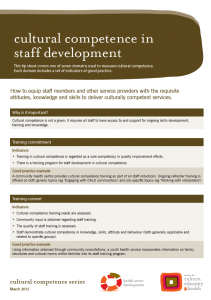How Can We Help?
How to equip staff members and other service providers with the requisite attitudes, knowledge and skills to deliver culturally competent services.
Why is it important?
Cultural competence is not a given; it requires all staff to have access to and support for ongoing skills development, training and knowledge.
Training commitment
Indicators
Training in cultural competence is regarded as a core competency in quality improvement efforts. • There is a training program for staff development in cultural competence.
Good practice example
A community health centre provides cultural competence training as part of all staff inductions. Ongoing refresher training is offered on both generic topics (eg ‘Engaging with CALD communities’) and job-specific topics (eg ‘Working with interpreters’).
Training content
Indicators
- Cultural competence training needs are assessed.
- Community input is obtained regarding staff training.
- The quality of staff training is assessed.
- Staff demonstrate cultural competence in knowledge, skills, attitude and behaviour (both generally applicable and related to specific groups).
Good practice example
Using information obtained through community consultations, a youth health service incorporates information on family structures and cultural norms within families into its staff training program.
Staff performance
Indicators
- Cultural competence is incorporated into job descriptions.
- Staff performance evaluations are conducted in a culturally competent manner.
Good practice example
At group supervision, staff members of a counselling service present examples of cross-cultural situations they encountered in their practice. The group then workshops each example and documents lessons learnt.
Reference
This tip sheet is based on Indicators of Cultural Competence in Health Care Delivery Organisations: An Organisational Cultural Competence Assessment Profile, prepared by the Lewin Group Inc. under contract with the USA Department of Health and Human Services (2002).
English Resource:
Last reviewed:
Links to the seven domains of the cultural competence framework
The eight tip sheets in this series cover different domains. These domains are interrelated and provide a comprehensive framework for assessing and improving cultural competence.
A framework for Cultural Competence
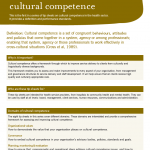
This is the first in a series of tip sheets on cultural competence in the health sector. It provides a definition and performance standards.
Governance

How to embed cultural competence in your organisation’s advisory bodies, policies, standards and goals.
Planning, monitoring & evaluation

How to ensure that programmatic and operational plans address cultural competence issues, and how to track and assess your organisation’s progress.
Communications
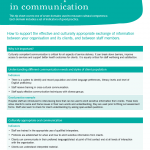
How to support the effective and culturally appropriate exchange of information between your organisation and its clients, and between staff members.
Staff development
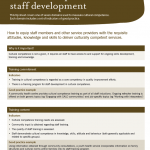
How to equip staff and service providers with the attitudes, knowledge and skills needed to deliver culturally competent services.
Organisational infrastructure
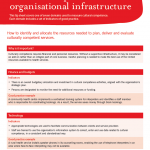
How to identify and allocate the resources needed to plan, deliver and evaluate culturally competent services.
Services & intervention
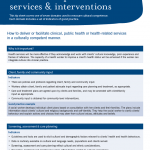
How to deliver or facilitate clinical, public health or health-related services in a culturally competent manner.
Organisational values
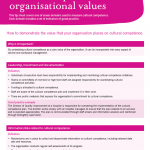
How to demonstrate the value that your organisation places on cultural competence.
Resource Type: Tip/Fact Sheets

